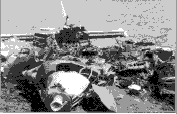Seat-Back Failure Causes Loss of Control
|
|
|
The Cessna 310 was observed in a cruise configuration low pass over the private strip. As the aircraft reached the end of the runway, the pilot pulled the aircraft into a steep climb. The aircraft continued to climb steeply until it stalled and entered a flat spin. It hit the ground with no forward speed. The pilot and his passenger died. The aircraft was destroyed in the ensuing fire.
The TSB (A95O0078) concluded that, when the pilot initiated the abrupt pull up, his weight overloaded the design specifications of the seat back, causing it to fail rearward. With the sudden G loading, the pilot fell backward when the seat failed, pulling the control column fully aft. Hanging back from the yoke, he was physically unable to recover from the low altitude stall/spin.
The TSB Engineering Laboratory confirmed that the seat met the design specifications set out in Technical Standard Order TSO 25a. The TSO requires that the seat support a 190 lb. pilot throughout all normal flight manoeuvres (maximum manoeuvring load of 2G). If the 380 lb. pilot (at double the weight in the certification standard) pulled the aircraft nose up to 45° in a smooth 2G manoeuvre, his weight on the back of the seat would have greatly exceeded the ultimate load limit. The Lab found that the seat back had failed in overload.

Non-survivable
Recognizing that people today are bigger, TSO-25a was changed in 1969 and again in 1983. However, there are still a lot of older aircraft built to the old design standards. Creative solutions might see periodic dye-penetrant testing or the x raying of seat fittings, medical restrictions on pilots' weight or a placard on the aircraft seat with a weight restriction on the pilots who fly these older birds.
Originally Published: 2/1997
Original Article: Seat-Back Failure Causes Loss of Control










